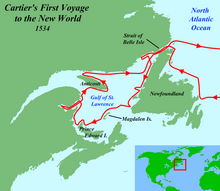Jacques Cartier

Jacques Cartier (born December 31, 1491 in Rothéneuf near Saint-Malo , Bretagne ; † September 1, 1557 ibid) was a French explorer and navigator .
youth
Not much is known about his youth, except that he probably came into contact with seafaring at an early age. It is believed that he was the son of Jamet Cartier and Jesseline Jansart. In 1520 he married Catherine, the daughter of Jacques des Granches and Françoise du Mast. This connection improved his reputation and social position significantly. Apparently there were no surviving offspring. His knowledge of the sea was valued so widely that the administration of his city was entrusted to him.
Voyages of discovery
From King Francis I , Cartier received the supreme command of two ships that left Saint-Malo on April 20, 1534 in order to find a western passage to the Far East . The crossing across the Atlantic lasted 20 days; around May 10th he passed the north coast of Newfoundland , sailed through the Belle Isle Strait, and on July 6th reached the Baie des Chaleurs . It was the first contact with Native Americans from the Algonquian -Volk the Mi'kmaq . Then he drove up the Gulf of St. Lawrence and sailed around almost all of Newfoundland. In September 1534 Cartier sailed back to France. He could not find the passage to the Far East he had hoped for, but was firmly convinced that he would be able to find it at a later point in time. Cartier also brought two natives with him to France, whom he hoped would be able to help him find the West Passage.
On May 19, 1535 Cartier set out on the second voyage. With him came 110 men and the two natives. Cartier reached and examined the St. Lawrence River and arrived in the heavily fortified Iroquois village of Hochelaga on October 2nd . The mountain above the village was called Mont Royal ("royal mountain") and gave the present day city of Montreal its name. In November 1535, Cartier decided to spend the winter in the area, probably also because a return trip was no longer possible due to the frozen waters. The team suffered from scurvy , which was an unknown disease at the time, the cause of which could not be understood. Fortunately, the Newfoundland natives saw the signs of the disease and saved the lives of many of the crew with a brew of pine needles, which is high in vitamin C. Even so, the illness remained a problem on board due to the unbalanced diet. He returned to Europe in 1536; 85 of the 110 man crew had survived.
In 1540 the sailor and privateer Jean-François de La Rocque de Roberval was given permission to set up a settlement in Canada at his own expense and the king's expense . Cartier was sent out on three ships for this purpose. He built Fort Charlesbourg-Royal near the present-day city of Québec near the village of Stadacona , examined the river and overwintered again. Cartier returned to Europe in June 1542. In 1544 he was commissioned to bring de Roberval and his people back to France.
The systematic exploration and colonization of the areas in eastern Canada did not begin until 1603 by Samuel de Champlain , the founder of New France .
A street in Montreal is named after Cartier , the Rue Cartier , and the highest mountain in the south of the province of Québec , the Mont Jacques-Cartier . In 1984, to commemorate the 450th anniversary of Cartier's first voyage, the first edition of the Transat Québec Saint-Malo ocean-going regatta , which leads from Québec to Cartier's birthplace, was held.
literature
- Henri V. Michelant (Ed.): Jacques Cartier, Voyage de J. Cartier au Canada . Éditions Tross, Paris 1865
- Léon Riotor: Jacques Cartier et le voyage au Canada. Chronique de la Nouvelle-France (La vie des grands découvreurs). Edition Roger, Paris 1937
- Jacques Cartier: The Discovery of Canada 1534–1542. Translator: Alexandra Maria Lindner, Niels-Arne Münch. Edition Erdmann , imprint from Verlagshaus Römerweg , Wiesbaden 2015
- Jacques Cartier: Récits de mes voyages au Canada, 1534-1535-1540: textes et documents retrouvés. Ed. Pacifique Saint-Laurent, Montréal [1984?]
Web links
- Hans-Jürgen Huebner: Jacques Cartier
- Jacques Cartier , www.nationalgeographic.de
- Discours du voyage fait par le capitaine Jaques (sic) Cartier aux terres-neufues de Canadas ..., dit nouuelle France , historical edition from 1598, publisher Raphael du petit val, scan at Gallica
Individual evidence
- ↑ A memoir of Jacques Cartier, sieur de Limoilou, his voyages to the St. Lawrence, a bibliography and a facsimile of the manuscript of 1534 Volltext, New York 1906 edition
- ↑ http://www.mocavo.com/A-History-of-Vermont/103618/15
- ↑ A memoir of Jacques Cartier, sieur de Limoilou, his voyages to the St. Lawrence, a bibliography and a facsimile of the manuscript of 1534
| personal data | |
|---|---|
| SURNAME | Cartier, Jacques |
| BRIEF DESCRIPTION | French explorer and navigator |
| DATE OF BIRTH | December 31, 1491 |
| PLACE OF BIRTH | Rothéneuf Saint-Malo , Brittany |
| DATE OF DEATH | September 1, 1557 |
| Place of death | Rothéneuf near Saint-Malo , Brittany |

